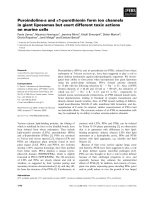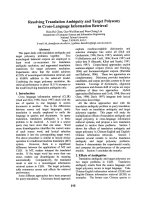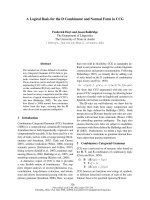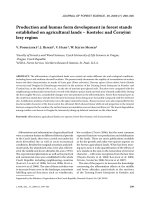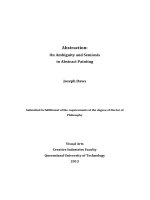AMBIGUITY AND EXAMPLES FORM ALICES ADVENTURE IN WONDERLAND
Bạn đang xem bản rút gọn của tài liệu. Xem và tải ngay bản đầy đủ của tài liệu tại đây (81.85 KB, 15 trang )
VIETNAM NATIONAL UNIVERSITY, HANOI
UNIVERSITY OF LANGUAGE AND INTERNATIONAL STUDIES
FACULTY OF GRADUATE STUDIES
AMBIGUITY AND EXAMPLES FORM
"ALICE'S ADVENTURE IN WONDERLAND
SEMANTICS FINAL ASSIGNMENT
Name: Lê Thị Nhung
Course: K18C
Instructor: Dr. Hà Cẩm Tâm
Deadline: 28/6/2010
Hà Nội, năm 2010
Ambiguity and Examples form "Alice's adventure in wonderland
TABLE OF CONTENT
I. INTRODUCTION
2
II. DEVELOPMENT
3
1. WHAT IS AMBIGUITY? WHEN DOES IT ARISE?
3
1.1.
Ambiguity - Ambiguity vs. Vagueness
3
1.2.
Cases of Ambiguity
4
2. LEXICAL AMBIGUITY
5
2.1.
Homonymy
5
2.2.
Polysemy
6
3. GRAMMATICAL AMBIGUITY
7
4. EXAMPLE OF AMBIGUITY IN THE NOVEL "ALICE'S
ADVENTURE IN WONDERLAND"
10
III. CONCLUSION
13
IV. REFERENCES
14
2
Le Thi Nhung - K18c
Ambiguity and Examples form "Alice's adventure in wonderland
I.
INTRODUCTION
Ability to have linguistic communication is one of the outstanding features
of human beings in such a colorful natural world. Language can be considered as
the greatest achievement in human evolution, which distinguishes man and animal.
Along the magnificent developing progress of sciences throughout thousands and
thousands years, this distinguished feature has proved that it is as complicated as
human beings themselves.
At the center of that development, human being has turned the complicated
things into an art, including the art of using language. With the personal interest in
linguistic uses, I myself want to find out more about meaning of sentences and
utterances. In the process of finding the problem, the attraction of ambiguity
caught my eyes and my mind. But in such limited time and capacity, I can only
devote to write such a small review. Hopefully the future will bring more chance
for my findings about this problem.
3
Le Thi Nhung - K18c
Ambiguity and Examples form "Alice's adventure in wonderland
II.
DEVELOPMENT
1. WHAT IS AMBIGUITY? WHEN DOES IT ARISE?
1.1. Ambiguity - Ambiguity vs. Vagueness
Cann (1993) stated that: "A sentence is said to be ambiguous whenever it
can associated with two or more different meanings." In other words, ambiguity is
the property of being ambiguous, where a word, term, notation, sign, symbol,
phrase, sentence, or any other form used for communication, is called ambiguous
if it can be interpreted in more than one way. Ambiguity is different from
vagueness, which arises when the boundaries of meaning are indistinct. Ambiguity
is context-dependent: the same linguistic item (be it a word, phrase, or sentence)
may be ambiguous in one context and unambiguous in another context. For a
word, ambiguity typically refers to an unclear choice between different definitions
as may be found in a dictionary. A sentence may be ambiguous due to different
ways of parsing the same sequence of words.
Ambiguity is to be distinguished from vagueness. According to Quine
(1960:29), "vague terms are only dubiously applicable to marginal objects, but an
ambiguous term such as "light" may be at once clearly true of various objects
(such as dark feathers) and clearly false of them." A term is vague if and only if
there are cases in which it is unclear whether or not the term applies. A vague term
is not ambiguous as far as it fails to have two or more distinct meanings, however,
many terms are both vague and ambiguous. A term is vague just in case there are
cases in which it is unclear whether or not the term applies. In other case, some
term is vague because there are borderline areas in a continuum, where it is
unclear whether or not the term applies.
E.g., “little,” “close,” “new,” “young,” “fat,” “wealthy,” “thick” and many
color terms.
Take “young.” Teenagers are young. 50 year-old men are not young. But
are 30 year-old men young?
4
Le Thi Nhung - K18c
Ambiguity and Examples form "Alice's adventure in wonderland
Other term is vague because there are several criteria for application of the
term with no standard of how many of the criteria need be fulfilled and to what
degree.
E.g., “philosophy,” “religious (person),” “resident,” “adult” and “tree.”
1.2. Cases of Ambiguity
Ambiguity comes in two different forms: Lexical and grammatical
ambiguity. When it comes to the ascription of multiple meanings to single words,
lexical ambiguity arises while grammatical ambiguity is the assignment of
different syntactic structures to a sentence.
For example:
(1) She has gone out, to the bank.
(2) The strike was called by lecturers who are radical
and by students
The first source of ambiguity occurs where an expression is associated with
two or more unrelated meanings, as in (1) where word "bank" may be interpreted
as "an organization where people and businesses can invest or borrow money,
change it to foreign money, etc. or a building where these services are offered"
(Cambridge advanced learners' dictionary) a or as the "sloping raised land,
especially along the sides of a river. Lexemes whose word forms have this
property are called homonyms, which will be discussed more detailed later.
A more interesting source of ambiguity from the point of view of the formal
semanticist is illustrated in (2). Here the ambiguity results from the possibility of
assigning two or more syntactic structures to a single grammatical string of words.
To ascertain the meaning of (2), for example, it is necessary to know whether the
adjective radical modifies the nominal phrase, lecturers and students, in which
case both the lecturers and the students who called the strike are radical, or
whether it modifies just the noun lecturers, in which case the lecturers who called
the strike are said to be radical but the political attitude of the students who did so
is not specified.
5
Le Thi Nhung - K18c
Ambiguity and Examples form "Alice's adventure in wonderland
Ambiguity may arise when a distinction is not made between the use and
the mentioning of a word or phrase.
Example:
Tom said I was angry.
Tom said, “I was angry.”
The two sentences express two very different things even though the words are the
same. This occurs because the phrase “I was angry” is being used in the first case
and mentioned in the second. Or the example of "Paddy is Irish" is ambiguous
whether Paddy refers to a person or the name.
2. LEXICAL AMBIGUITY
Lexical ambiguity, as mentioned above, arises when a word or a phrase
could, in the context of a particular sentence, refer to two more properties or
things, typically caused by homonymy and polysemy. Homonymy refers to a
situation where different words happens accidentally to have the same forms while
polysemy designates a situation in which a single word has a set of related
meanings.(Hoa, 2004:68)
2.1. Homonymy
Homonymy can be subdivided into homophones, where the forms of
lexeme sound the same but written differently, e.g. draft and draught which can
both be represented phonemically as /draft/, and homographs, e.g. lead, which are
written the same, but which are pronounced differently. Some lexemes are both
homonyms (like bank, punch), where all of the lexeme's associated word forms are
phonetically or orthographically identical, and partial homonyms (like find,
found), where just some of its word forms are identical. Lyons (1996:56) takes the
example:
They found hospitals and charitable institutions.
He argues that because "found" and "find" are transitive verbs and both can
take the noun phrase "hospitals and charitable institutions" as direct object, which
makes the sentence not only grammatically but also semantically acceptable.
The ambiguity here is partly lexical and partly grammatical. It is lexically
ambiguous because its ambiguity depends up on a difference in the lexical
meaning of the two partially homonymous lexemes "found" and "find". It is
6
Le Thi Nhung - K18c
Ambiguity and Examples form "Alice's adventure in wonderland
grammatically ambiguous in because its ambiguity depends upon the grammatical
non-equivalence of these two words. To eliminate the ambiguity, we can
manipulate the grammatical environment in such ways as:
They have found hospitals and charitable institutions.
She/he found hospitals and charitable institutions.
They founded hospitals and charitable institutions.
Besides, it is quite possible for the partial homonymy rarely or never result
in ambiguity. For example:
Last week, I went out with some friends.
Concrete will last longer.
The form "last" is almost always grammatically identifiable when it occurs
in a sentence or context.
2.2. Polysemy
Homonymy is often contrasted with polysemy. "A polysemous lexeme is
one the is interpreted as having multiple senses that are not entirely distinct, as is
the case in the standard examples of homonyms."(Cann, 1993:8). The classic
example of a polyseme in English is the lexeme Mouth which has different
interpretations depending on what sort of entity is described as having a mouth.
There are, for example, human mouths, mouths of caves, mouths of bottles,
mouths of rivers, and so on. In each of these cases, the properties of the entity
described by mouth are different but not absolutely different, as each one refers to
an opening of some sort. The difference between homonymy and polysemy is one
of degree, and precise definitions of these terms are difficult and controversial.
Hughes and Lavery (2004:65) considers a broader term "referential
ambiguity and gives the example:
Pavavrotti is a big opera start.
He argues that the ambiguity arises since "big" may refers to either "fat" or
"famous". There is another type of referential ambiguity that deserves special
mention: collective and distributive use of term. Nouns which refer to a each
member class of individual object, like dog for the class consisting of all dogs, are
distributively used. In contrast, nouns used to say about the whole class is
collectively used. He gives the example:
Our university has a large wrestling team.
7
Le Thi Nhung - K18c
Ambiguity and Examples form "Alice's adventure in wonderland
If the term "wrestling team" is distributively interpreted, the statement
means that the individual members of the team are large. If it is collectively
interpreted, the statement means that the team has a large number of member.
The context plays an important role in avoiding misunderstanding, but
sometimes it cannot complete that mission. More example can be listed as
followed:
Tom gave Ted's skis to his sister.
Harold told me that he would do it next week.
Americans make more telephone calls than Canadians.
The government has provided constant finding for post-secondary
education over last three years.
3. GRAMMATICAL AMBIGUITY
According to Matthews (2000), grammatical ambiguity refers to ambiguity
explained by differences in syntax. E.g. I read the book on the floor might mean
that a book was on the floor and that was the one the speaker read: this would
reflect a syntactic construction in which on the floor modifies book. Alternatively,
it might mean that the speaker was on the floor while reading the book: this would
reflect a construction in which on the floor modifies read or read the book. It is
also called ‘constructional homonymy’.
Grammatical ambiguity arises when the grammatical structure of a sentence
allows two interpretations, each of which gives rise to a different meaning. Hughes
and Lavery (2004) use a sentence from news report in England to illustrate:
Lord Denning spoke against the artificial insemination of women in the
House of Lord.
They argue that the grammar makes it unclear whether it was the speech or
the insemination that took place in the House of Lords. This is because the phrase
"in the House of Lords could modify either "insemination" or "spoke". There are
also other examples to consider:
(3) The bully hit the boy with the snow ball.
(4) We need more intelligent leaders.
8
Le Thi Nhung - K18c
Ambiguity and Examples form "Alice's adventure in wonderland
Example (1) can be interpreted into:
(3a) The bully threw a snowball at the boy.
(3b) The bully hit a boy who was holding a snowball.
Example (4) can be interpreted into:
(4a) We need a greater number of intelligent leaders.
(4b) We need the leaders who are smarter.
Back to the example number (2), the problem of which noun is modified
turns out to be clearer. The sentence can be interpreted as followed:
(2a) The strike was called by lecturers who are radical and by students
(2b) The strike was called by lecturers who are radical and by students who
are radical
In the above example, what is at issue is the scope of the adjective, radical. In
(2a), it modifies and thus has scope over, the noun lecturers, why in (2b) its scope
is the nominal phrase lecturers and students. Scope is an important concept in
semantics and primary source of ambiguity, which involves not only adjectives,
but also conjunctions, like and, or, etc and quantifiers, like every, all, and some in
English. Structural ambiguity of this sort thus has it source in the syntax of
language. However, there are other scope ambiguities that do not directly depend
on syntactic structure of a sentence. Such ambiguity usually involves negation
(not), quantification (every, some) and other elements like tense, which do not
vary their syntactic position according to the reading of the sentence. Example:
(3) Every politician loves a cause.
The two readings here can be made clear by those:
(3a) Every politician loves a cause and that is their own career.
(3b) Every good politician loves a cause and each one loves a cause
that everyone else loathes
In (3a), there is only one cause that every good politician love a different
cause. The sentence in (3b), however, is usually only assigned a single surface
constituent structure, so that this ambiguity cannot be directly attributed to a
syntactic source and is referred to as a semantic scope ambiguity.
An adequate semantic theory must be able to predict where structural
ambiguity is likely to arise in a language and provide a means of differentiating
9
Le Thi Nhung - K18c
Ambiguity and Examples form "Alice's adventure in wonderland
the interpretations of the different structures to an ambiguous sentence by the
grammar, where this is relevant. It should also ensure that sentences that have two
(or more) syntactic derivations, but only one semantic interpretation, are not
assigned more than one meaning. The theory should also provide an account of
scope ambiguities where these are not reflected in syntactic derivations, and be
able to differentiate the scopes of particular expressions independently of syntax.
Three simple examples will illustrate some different types of scope
ambiguity and their representation in an informal first order predicate logic, using
restrictions on quantifiers and an infix notation for sentential formulas. The
meanings of the different interpretations should be clear. The example of Sven
Hurum (1988): "John didn’t meet Jane or Mary" can be made clearer as: "John
didn't meet either Jane or Mary" or that he didn't meet at least one of them.
4. EXAMPLE OF AMBIGUITY IN THE NOVEL "ALICE'S
ADVENTURE IN WONDERLAND"
Alice's Adventures in Wonderland (commonly shortened to Alice in
Wonderland) is an 1865 novel written by English author Charles Lutwidge
Dodgson under the pseudonym Lewis Carroll. Stand in BBC's Greatest English
Books list, it tells the story of a girl named Alice who falls down a rabbit hole into
a fantasy world populated by peculiar and anthropomorphic creatures. The tale
plays with logic in ways that have given the story lasting popularity with adults as
well as children. It is considered to be one of the best examples of the literary
nonsense genre, and its narrative course and structure have been enormously
influential, especially in the fantasy genre.
Throughout the story, the art of writing by Lewis Carroll is both
comprehensive and interesting, leads the reader in to a real wonderland of the
language. Ambiguity here is among his most frequent uses.
In the situation where Alice and everyone (the mouse and other animals) are
totally wet (in the pool of tears), they need to get dry quickly, but the term "dry"
the mouse mention means "boring".
10
Le Thi Nhung - K18c
Ambiguity and Examples form "Alice's adventure in wonderland
"At last the Mouse, who seemed to be a person of authority among them, called
out, `Sit down, all of you, and listen to me! I'LL soon make you dry enough!'
They all sat down at once, in a large ring, with the Mouse in the middle.
Alice kept her eyes anxiously fixed on it, for she felt sure she would
catch a bad cold if she did not get dry very soon. `Ahem!' said the
Mouse with an important air, `are you all ready? This is the driest
thing I know. Silence all round, if you please! "William the Conqueror,
whose cause was favored by the pope, was soon submitted "to by the
English, who wanted leaders, and had been of late much accustomed to
usurpation and conquest. Edwin and Morcar, the earls of Mercia and
Northumbria--"'
Then comes the history of the mouse. The homonymy "tail" vs "tale" makes
little Alice "puzzling" here:
`Mine is a long and a sad tale!' said the Mouse, turning to Alice, and
sighing. `It IS a long tail, certainly,' said Alice, looking down with
wonder at the Mouse's tail; `but why do you call it sad?' And she kept on
puzzling about it while the Mouse was speaking, so that her idea of the
tale was something like this…"
The conversation with the Caterpillar may be one of the most interesting parts:
`Explain yourself!'
`I can't explain MYSELF, I'm afraid, sir' said Alice, `because I'm not
myself, you see.'
`I don't see,' said the Caterpillar.
Or:
The Caterpillar was the first to speak.
`What size do you want to be?' it asked.
`Oh, I'm not particular as to size,' Alice hastily replied; `only one doesn't
like changing so often, you know.'
`I DON'T know,' said the Caterpillar.
Another example is that:
And how many hours a day did you do lessons?” said Alice, in a hurry
to change the subject.
“Ten hours the first day,” said the Mock Turtle, “nine the next, and so
on.”
11
Le Thi Nhung - K18c
Ambiguity and Examples form "Alice's adventure in wonderland
“What a curious plan!” exclaimed Alice.
“That's the reason they're called lessons,” the Gryphon remarked:
“because they lessen from day to day.”
The author seems to be very well playing with language, which is the main
attraction the novel. Generations of children and adults also are fascinated by the
strange, exciting adventure and an innocent Alice, who is very much like one of
us. To reach such marvelous success, Lewis Carroll has showed off her talent in
words and sentences in such a beautiful way.
12
Le Thi Nhung - K18c
Ambiguity and Examples form "Alice's adventure in wonderland
III. CONCLUSION
Semantic Ambiguity is one of the most interesting topic in human language
and conversation.
Because of the limited time and capacity, all the interesting example cannot be
fully listed and carefully analyzed. Hopefully in the future, I would have some
chance to come back with this topic as well as my ever favorite story "Alice's
adventure in wonderland".
13
Le Thi Nhung - K18c
Ambiguity and Examples form "Alice's adventure in wonderland
IV.
REFERENCES
Cann, R. (1960). Formal semantics: an introduction. Cambridge: Cambridge
University Press.
Hughes, W. & Lavery, J. (2004). Critical thinking: an introduction to the basic
skills. Toronto: Broadview Press Ltd.
Hurum, S. (1988). Handling scope ambiguity in English Department of
Computing Science. University of Alberta, Edmonton, Canada
Lyons, J. (1996) Linguistic semantics: an introduction. Cambridge: Cambridge
university press
Matthews, P. (2000). Oxford Concise Dictionary of Linguistics. Oxford: Oxford
University Press.
Nguyen, H. (2004). Understanding English Semantics. Hanoi: Vietnam National
University Hanoi Press.
Quine, W. (1960). Word and Object. The MIT Press, Cambridge, MA.
Suzuki, M. (2007). The Best Imperative Approach to Deontic Discourse. From the
world wide web: />
14
Le Thi Nhung - K18c
